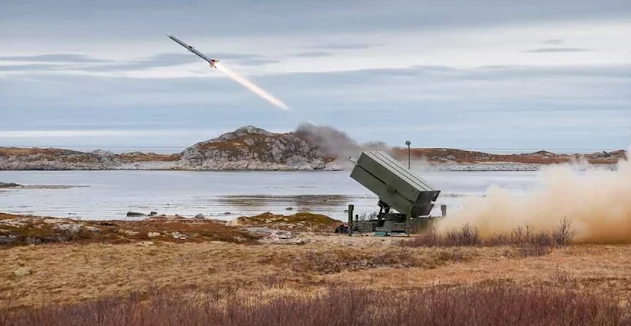 |
| AIM-120 rocket launch from NASAMS launcher |
International Military - Tensions between Russia and Ukraine are still not over. Both Russia and Ukraine attack each other to the point of destroying anything in their path. To deal with the destruction suffered by its air defense systems as a result of Russian air strikes, Ukraine will be provided with a modern air defense system.
The modern Norwegian Advanced Surface to Air Missile System (NASAMS) air defense system will defend Ukrainian airspace against Russia. The NASAM air defense system was developed by the Norwegian defense company Kongsberg Defense and Aerospace in collaboration with the US company Raytheon.
Quoted from Defense Security Asia, the NASAMS air defense system was also offered to Malaysia for the Medium Range Air Defense System (MERAD) procurement program. Perhaps the Royal Malaysian Air Force, as operator of the Malaysian MERAD system, can use the performance of NASAMS in Ukraine as a benchmark in deciding what MERAD system to acquire.
Ukraine is said to have 100 batteries of S-2300 air defense systems but failed to deal with Russian fighter jet air strikes, prompting several European countries and the United States to act on Western-made air defense systems.
Apart from NASAMS, Germany is also reportedly in the process of delivering the IRIS-T SL M (Surface Launched Medium) air defense system designed and developed by the German company Dielhl BGT Defense to defend Ukrainian airspace.
This medium-range air defense system developed by the German company can deal with any air threat up to a maximum range of 40 km.
Seven weeks after the Russian offensive on Ukraine began last February, Western defense observers have identified at least 21 of the 100 batteries of Ukrainian S-300 air defense systems that have been destroyed by Russian fighter jets.
Now that July has entered, it is unknown how many S-300 batteries belonging to Ukraine remain to monitor the country's airspace. In a bid to further strengthen control of Ukrainian airspace, the United States last Friday announced it would provide US$820 million worth of military aid to Eastern European countries.
Military assistance by Washington also includes the NASAMS air defense system and artillery fire detection radar as well as about 150,000 155mm artillery shells delivered under the Ukraine Security Assistance Initiative.
In addition, US$50 million worth of military aid will also be used to supply more High Mobility Artillery Rocket Systems (HIMARS) rockets to Ukraine. The Ukrainian military is said to have used the HIMARS system effectively against the Russian command and control center.
The NASAMS air defense system is part of the NATO air defense system and is also used by the United States to defend the White House and the Pentagon against any air threats.
What's interesting about this NASAMS medium-range air defense system is that it uses the AMRAAM (Advanced Medium Range Air-To-Air-Missile) missile developed by the Raytheon company. This is the same missile used by warplanes including the RMAF F/A-18D Hornet.
In one standard NASAMS unit, it will consist of an FDC Fire Distribution Center, an active AN/MPQ64F1 Sentinel 3D radar, passive electro-optical and infrared sensors and several AMRAAM missile tubes. The engagement mode for the NASAMS system is 180km away. At that time the NASAM air defense system was also used by Indonesia and Australia.
Ukrainian troops have withdrawn from the bombed city of Lysychansk, prompting Russia to claim full control of the eastern Luhansk region, the Kremlin's main war goal, but President Volodymyr Zelenskiy vowed to regain lost territory.
On Sunday 3 July 2022, Ukraine said a tactical withdrawal would save the lives of its soldiers who would regroup to launch a counter-offensive with the help of Western long-range weapons.
But Moscow says Lysychansk's arrest less than a week after taking in neighboring Sievierdonetsk means it has "liberated" Luhansk.
It said it would give Luhansk to the self-proclaimed Russian-backed Luhansk People's Republic whose independence was recognized on the eve of the war. The focus of the battlefield is now shifting to the nearby Donetsk region, where Kyiv still controls most of the territory.
Zelenskiy said Russia was concentrating its firepower on the Donbas front, but Ukraine would retaliate with long-range weapons such as the US-supplied HIMARS rocket launcher. "The fact that we protect the lives of our soldiers, our people, plays an equally important role. We will rebuild the walls, we will win back the land, and the people must be protected above all else."
Since abandoning the offensive in the capital Kyiv, Russia has concentrated its military operations in the Donbas industrial heartland of the Luhansk and Donetsk regions, where Moscow-backed separatist proxies have been battling Ukraine since 2014.
Russian Defense Minister Sergei Shoigu told President Vladimir Putin that Luhansk had been "liberated", the defense ministry said, after Russia earlier said its troops had captured villages around Lysychansk and surrounded the city.
Ukraine's military command said its troops had been forced to withdraw from the city. Ukrainian officials, who say references to "liberating" Ukrainian territory are Russian propaganda, have reported intense artillery barrages in residential areas.
West of Lysychansk in the Donetsk region, at least six people died when the Ukrainian city of Sloviansk was hit by heavy fire from multiple rocket launchers on Sunday, local officials said.
